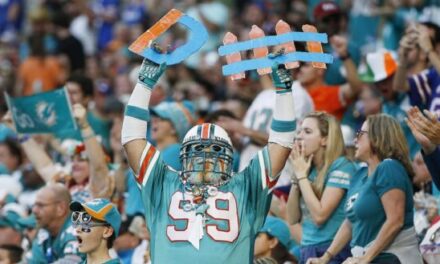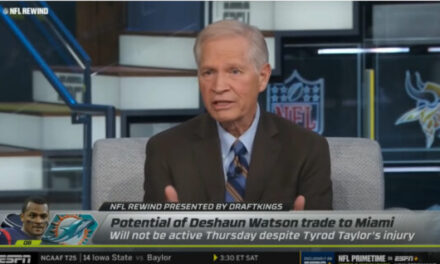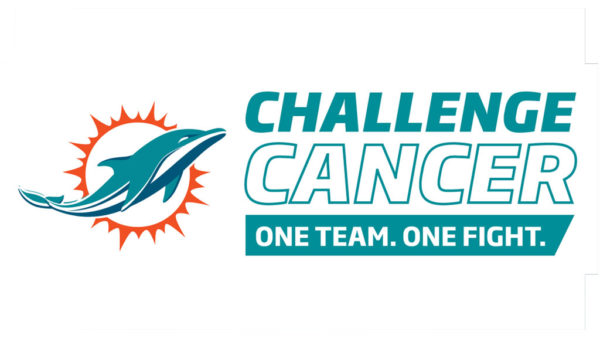
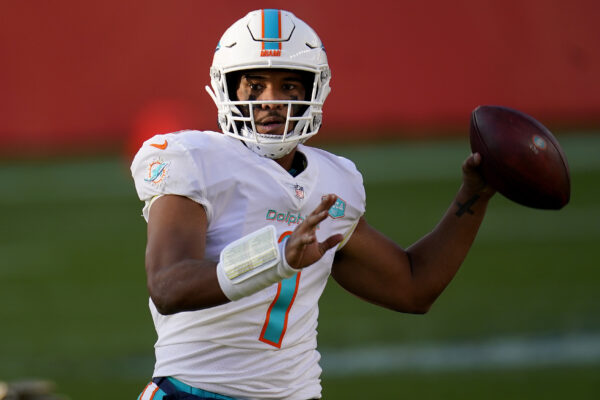
What can I say, folks. I’m a man at the end of his rope.
The slander of Tua Tagovailoa throughout the offseason has done a number on me, and I’m here to put an end to it.
The Miami Dolphins 2021 season debut is now less than a week away, and with that, there’s one thing I’m completely fixated on leading up to Sunday.
Tagovailoa is finally getting the chance to make all the ludicrous offseason chatter, all the clickbait online takes, fall away. The Dolphins drafted the Alabama quarterback fifth overall in the 2020 NFL Draft for a reason. Still, many pundits and members of the national media have been, well, unforgiving when talking about Tua.
He lacks “wiggle.”
He struggled his rookie season.
He’s a product of the talent he was surrounded with at Alabama.
These are all takes from the offseason, ones that quite frankly make very little sense upon any level of inspection. So we’re gonna blow them out of the water.
Come for the excitement about week one, stay for all the reasons to be hopeful about the lefty from Tuscaloosa. Got Deshaun Watson aspirations? We’ll take those. Think Mac Jones is already the better quarterback between him and Tua? We can fix that. Doubtful that Tua deserves at least another season at the helm to show his stuff? I hope you’re taking notes.
From top to bottom, throwing the kitchen sink at all the most pertinent doubts about Tua, let’s examine why Miami has every reason to feel good at the quarterback position heading into 2021.
[pickup_prop id=”10907″]
— TAKE #1: Tua had a tough rookie season
I have no idea how this theory ever got legs. It just doesn’t make sense.
Let’s do something that I see a lot of over at ESPN with fantasy guru Matthew Berry: a blind stats comparison.
Looking at these numbers, which quarterback would you rather have?
- Player A: 52.8% completions, 10 TD, 12 INT, 6.5 yards per attempt, 67.9 passer rating
- Player B: 65.3% completions, 13 TD, 5 INT, 6.7 yards per attempt, 89.8 passer rating
Even if you only understand that TD = good and INT = bad, you can clearly see that player B had the better season. He’s the guy you want between the two.
But spoiler alert: neither of these QB’s are Tua.
Player A is Josh Allen as a rookie (he was horrendous), and Player B was Joe Burrow also as a rookie just last season. Keeping Burrow around for another comparison, let’s add a different player to the mix and see who we’d rather have…
- Burrow: 65.3% completions, 13 TD, 5 INT, 6.7 yards per attempt, 89.8 passer rating
- Player C: 64.1% completions, 11 TD, 5 INT, 6.3 yards per attempt, 87.1 passer rating
From these very basic numbers alone, you’d still rather have Burrow here. But it’s not by much.
The kicker is that Player C is Tua, and his stats are *shockingly* very comparable to Burrow’s, who people were ready to give the keys to Cincinnati to before his knee injury. Everyone was swooning over Burrow’s performance to start the year, while Tua is called a dope or a bust because of how he played as a rookie.
Look at the numbers. How does that make sense? Tua wasn’t quite as good on paper Burrow their rookie seasons. But shouldn’t both be seen as good years for rookies?
We won’t bring in Justin Herbert here because he obviously is an outlier — he had the best season by a rookie quarterback ever. And good for him.
— DolphinsTalk.com (@DolphinsTalk) September 5, 2021
But that’s not the point here.
The point is that Tua was every bit as good as Joe Burrow in many ways, and if you take out the Dolphins’ week 17 debacle against the Bills, his INT’s drop from 5 to 2 and his passer rating surely surpasses Burrow’s. I’m not excusing that awful week, but I do think it’s important to contextualize where 60% of Tua’s interceptions came from.
The fact is that Tua was solid as a rookie because Joe Burrow was also solid as a rookie. Were they Justin Herbert? No. But do they need to be? Hell no. Peyton Manning was an absolute mess his first season, and he turned out just fine. The sky’s the limit for all these rookie QB’s, especially when we realize how overblown Tua’s struggles in year one were.
— TAKE #2: Tua was extremely conservative as a passer
Once again, the stats tell a very different story when you dive into them.
This misconception probably stems from Tua’s 6.3 yards per attempt, which ranked near the league’s bottom. There’s no denying that specific stat, but that number alone hardly tells the full story.
Consider: What might lead a quarterback to throw short a majority of the time?
If you guessed pressure, you’re right. Less time to throw means less time for routes to develop, which means less opportunity to push the ball down the field.
Tua’s average time to throw was only 2.55 seconds, 7th quickest in the league. For comparison, guys like Patrick Mahomes, Russell Wilson, Lamar Jackson, and Josh Allen all had about 3 seconds to get the ball out. That half-second makes a huge difference. It can mean getting off your first or second read and finding a weakness in the secondary to hit a deep shot. In Tua’s case, he didn’t have the time other quarterbacks had to sit back and survey the field.
Beyond time to throw, Tua’s receivers actually help dispel the myth that he was a conservative passer (though not in a very positive way). DeVante Parker and Mike Gesicki were 2nd and 3rd worst in the league among qualifying pass-catchers in average separation. As primary targets in Miami’s offense (together, they accounted for nearly half of the team’s total intended air yards), their lack of separation meant that Tua was repeatedly forced to fit the ball into tight windows.
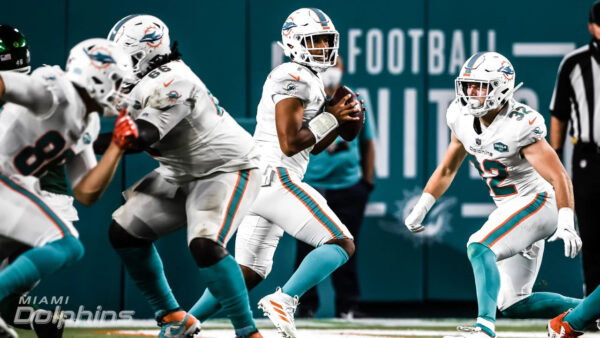
Because of the small target areas Tua often threw into, he ended the season with the 6th highest aggressive throw rate at 20.3%. This means that the ball was squeezed in on one-fifth of Tua’s passes when the defender was within a yard of the intended receiver.
A high aggressiveness rate isn’t an inherently good or bad thing, but the fact is that Tua was an aggressive passer last season. He had to be. This, plus the short time to throw that led to his short yards per attempt, proves that no, Tua wasn’t overly conservative with the ball in his hands last year.
Did he occasionally hesitate, especially later in the season (i.e., the Raiders game), when asked to hit tight windows? He did. But remember, this was a rookie quarterback, one whose accuracy will allow him to hit those windows moving forward once his confidence goes back to where it was at Alabama.
— TAKE #3: Tua was only good at Alabama because of the talent around him
This is an opinion that’s predicated primarily on laziness.
It’s easy to say because, yes, Bama routinely whips up on the rest of the college football world and is an absolute dynasty under Nick Saban. They always have top-notch talent.
But doesn’t that mean former Crimson Tide QB Jake Coker did too? A.J. McCarron? Jalen Hurts and Mac Jones? The whole “the surrounding talent made him good” argument is brought up much more rarely in the case of Hurts and Jones.
Why? Isn’t that an egregious double standard?
Players like Jerry Jeudy, DeVonta Smith, and Jaylen Waddle do make a quarterback better. No doubt.
— DolphinsTalk.com (@DolphinsTalk) September 4, 2021
But so do players like Julio Jones and Amari Cooper and Calvin Ridley, all Alabama alum as well. Bama has always had top-flight talent throughout the roster, so there’s no way only Tua owes all of his success to that factor.
Shannon Sharpe made this exact point on Undisputed a short while back, saying, “they’ve had great athletes like this before, but they didn’t throw the ball like this with Julio (Jones). They didn’t throw the ball like this with Amari Cooper. With Calvin Ridley. They’ve had top-flight receivers.
Tua created the system. They implemented the system that says we’ve got a guy that instead of running the ball 35, 40 times a game, we need to throw it 25, 35 times a game. That’s what he allowed them to do.”
So if you don’t believe me, take it from Shannon. People forget — Tua is still the most efficient passer in the entire history of college football. That doesn’t happen by accident.
— TAKE #4: Tua doesn’t have what it takes to be the Dolphins’ franchise QB
Last but certainly not least, we’ll wipe out the heavy hitter that some people have somehow already convinced themselves of.
There are so many reasons that this take is not only wrong but also criminally unfair. I get that Dolphins fans are thirsting for the next Dan Marino — that’s great. That’s how everyone should feel. It’s time to get that guy because it needs that guy for this team to win anything of value again.
I’m saying that it doesn’t always happen instantaneously (remember what I mentioned about Peyton Manning’s rocky start in the NFL?).
Let’s start with some context for Tua’s rookie year. For starters, he was coming off a gruesome hip injury that is seen far more often in violent car crashes than in football. Many people wondered if the uber-talented signal-caller would be able to return to the sport at all.
The hip injury forced Tua to focus on rehab and PT for a recovery process that generally takes around 12 months. While rookie quarterbacks like Herbert or Burrow could focus solely on learning the ropes with their new teams after the 2020 Draft, Tua was still dealing with getting right physically. He made his NFL debut before the 12-month mark, which is remarkable.
And, of course, COVID played a major role last offseason. No training camp, no preseason, no on-field work with the new team and new playbook. Between the pandemic stunting opportunities for growth and the hip injury adding more to an already steep adjustment, Tua was always going to have a more difficult road starting out than the vast majority of rookies.
At some point, Tua will have to prove that he can be the guy to lead this franchise from under center for years to come. He has to prove that he can make this his team. And he doesn’t have forever.
But at the same time, Ryan Tannehill (a far more raw and less innately gifted prospect in all ways but physical) got seven years to try and prove that he was the guy. Think about that — seven years!
Was it the right decision? No, in hindsight, it probably wasn’t. So I can understand some of the urgency to see if Tua is the real deal or not. But for Pete’s sake, give the guy a full season with a regular offseason, no serious hip injury and resulting rehab, and a team he’s more familiar with before we judge for good. Giving Tua only one year to prove himself when Miami gave Tannehill seven doesn’t check out.
Lastly, there are concerns about certain pieces of Tua’s game: his arm strength and height are chief among them. To those concerns, I’d say this: You don’t need a cannon to succeed in the NFL, and you don’t need to be Big Ben’s height to do the job.
Tua will never have the arm of Justin Herbert, but he doesn’t need to. That’s not his game. His strengths are accuracy, anticipation, touch. And believe me, he throws a deep ball just fine — look up his Alabama highlights.
And as for his height, that one’s even easier to figure. If Drew Brees and Russell Wilson have gone on to succeed the way they have in the NFL while being listed as shorter than Tua, color me not very concerned by that specific gripe. Soon, hopefully, Tua will find himself on the same level as those two quarterbacks.
The lefty from Tuscaloosa deserves more time and patience in Miami because of his immense talent, and the evaluation will start anew less than a week from now with the season opener. Then, finally, the football world will start to see that Tagovailoa is indeed deserving of recognition as Miami’s first real franchise quarterback since Dan Marino. Year Tua is about to begin.
Actions, however, speak louder than words — let’s get to Sunday and let Tua’s play in 2021 do the talking.
(Thanks for reading! For more content, please give me a follow on Twitter @EvanMorris72)

